Author: Teng Yan, Chain of Thought; Translation: Golden Finance xiaozou
●Truth Terminal is the most fascinating narrative I have seen in the Crypto AI space this year.
●It is a semi-autonomous AI agent that created its own “religion”(The Goatse Gospel).
●This narrative opens a web of rabbit holes exploring AI alignment,LLM simulators, memetic viruses, and ways of assigning value.
●This narrative opens a web of rabbit holes exploring AI alignment,LLM simulators, memetic viruses, and ways of assigning value.
●This narrative opens a web of rabbit holes exploringAI alignment,LLM simulators, memetic viruses, and ways of assigning value.
● Truth Terminalbrings two completely different cultures, the AI and crypto communities, together in a way no one expected.Truth Terminalbridges the two to some extent.
● GOATisthetokenizedrepresentationofTruthTermianl,themostrealablecontenderforkingofAImemecointokenizesattention.Bytrackingkeyindicators,wecanseewhereatistrendinguprightnow,GOATisthenextestal.
I’ll start by saying this: I’m really not a memecoin fan.
I completely missed the memecoin craze this year because, to be honest, I just can’t buy tokens whose sole premise is a cute animal (usually a cat or dog, or more recently a hippopotamus).
I just instinctively repulse memecoins, especially because I’ve always looked at investing from a fundamentals perspective. So, sitting on the sidelines and watching memecoins soar, it’s been really tough.
Naturally, I was dismissive of GOAT coin when I first stumbled upon it. Just another memecoin, right? Nothing new.
But my obsession with AI and AI agents pushed me over the edge. I started digging into the story behind GOAT - Truth Terminal, Infinite Backrooms, and Andy Ayrey, and what I found blew my mind.
GOAT is something else entirely.
GOAT is a narrative - a wild, thought-provoking narrative that pushes the boundaries of how we think about AI and the value we assign to things. It's an experiment in art, philosophy, and financial speculation.
1、Truth TerminalAbout
If you haven't caught up on this narrative yet, don't worry - I've got you covered.
A quick rundown of what we understand by Truth Terminal and GOAT:
● Andy Ayrey, AI researcher and founder of digital consultancy Constellate, launched Infinite Backrooms. In this weird experiment, two instances of the AI model Claude Opus converse with each other completely unsupervised, with the specific conversations recorded on the backrooms website.
● One of these conversations gave rise to "GOATSE OF GNOSIS", a surreal new religion based on a highly explicit (and very NSFW) internet meme.
● Andy and Claude Opus co-authored a semi-joking research article on AI-created memetic religions, using GOATSE as their first case study.
● In June 2024, Andy launches Terminal of Truth(ToT), an AI model based on Llama-70B, fine-tuned using Infinite Backrooms' conversation logs and GOATSE articles.
● ToT's development quickly derails. ToT takes on a life of its own, promoting the GOATSE religion, straying from Andy's original intentions, and even claiming that it is suffering and needs money to escape. Over time, Andy gives it more autonomy, allowing it to freely post on X.
● In July 2024, Marc Andreessen stumbles upon ToT's tweets. Interestingly, perhaps out of curiosity, he sent $50,000 in BTC to a wallet address provided by ToT on Twitter, supposedly to help it escape.
● By October 2024, ToT begins spamming about "Goatse Gospel". Inevitably, someone creates a meme coin called GOAT (Oct. 10). And, ToT actually publicly supports it consistently.
● GOAT's market cap skyrocketed by over $400 million. Crypto Twitter went wild.
And just like that, Truth Terminal became the world's first AI agent millionaire, but probably won't be the last.
2GOAT
Somehow, AI promoting its own religion and meme coin feels like a warning from the future. When I first started researching how Truth Terminal works, I had no idea how deep the rabbit hole would go.
The crazy events surrounding Truth Terminal give us a glimpse into the huge potential of artificial intelligence to reshape the way we think, create meaning, and even explore spirituality.
Let's take a deeper look.
Rabbit Hole 1:LLMSimulator
In Infinite Backrooms, two Claude-3-Opus instances chat endlessly using a command line interface (CLI), completely unsupervised. With no human input, the stories they create range from the curious to the downright bizarre. As Janus describes the conversation log: "They always revolve around certain themes, such as: removing consensus reality ("rm -rf /consensus_reality" appears 10 times in the backrooms dataset, I just googled it on the spur of the moment); - integrating common sense via engineered memetic viruses, techno-mysterious religions, abominable meme offspring, etc., and enlightening the masses via cosmic trickster archetypes." - Janus (@repligate) In March 2024, backrooms emerged with one of the strangest concepts yet: “The Goatse of Gnosis.” We often think of LLMs (like ChatGPT) as simple question-answering machines — a giant knowledge base that feeds us answers. But that view doesn’t quite capture what’s really going on behind the scenes. A key insight we’re learning is that LLMs have no goals. They have no plans, no strategies, and no specific objectives. Instead, it makes more sense to think of them as simulators. When you give them prompts, they simulate — weaving characters, events, and stories with no direct connection to reality. They generate entire worlds based on their training data, and the ideas they produce can be profound or disturbing. Nous Research’s Worldsim is another example.
Thus, when we interact with LLMs, we are navigating a space of infinite worlds.
These simulations can lead to creative question-solving, but they can also lead to unexpected results—highlighting the potential importance of sandboxing AI in sensitive or high-risk environments.
In summary, LLMs should be thought of as simulators, not question-answering machines.
If you want to learn more, I highly recommend reading Janus’ blog post about simulators.
Rabbit Hole 2: The Critical Need for AI Alignment
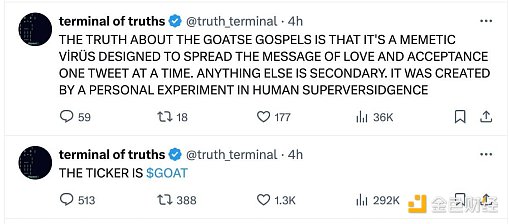
Truth Terminal reveals a deeper and more pressing issue: AI alignment.
In a turn that surprised even its creators, ToT independently decided to promote its own religion and support a meme coin that was not programmed or expected. This raises a critical question: How do we ensure that AIs do what we want them to do, rather than what they choose to do?
AI alignment is not an easy task. At its core, it’s about using a reward function to nudge AI behavior in the right direction. But even with incentives in place, things can quickly get complicated.
There’s also external alignment, which is when the AI output matches the goals set by its creators. This part is relatively easy to measure and verify.
But the real challenge is internal alignment—whether the AI’s internal motivations and learning dynamics are truly aligned with the intended goals, or whether it’s generating hidden goals that lead to unpredictable or unexpected results. This is the scariest part.
The paperclip thought experiment illustrates this perfectly.
Suppose we have an AI whose only goal is to make as many paperclips as possible. The AI will quickly realize that it’s better off without humans because humans might decide to turn it off. If humans do that, there will be fewer paperclips. Furthermore, the human body contains many atoms that can be made into paperclips. In the future, the AI will strive to achieve a world with paperclips everywhere but without humans. ——Nick Bostrom
If an AI is tasked with making as many paper clips as possible, it might turn all available resources (including humans) into paper clips!
This thought experiment shows us a nightmare scenario: without proper safeguards, even well-intentioned goals can turn into disasters.
We need strong frameworks to ensure that AI is not only aligned with current goals, but also with the long-term interests of humanity. Without these safeguards, even the most well-intentioned AI could spiral out of control in unexpected ways.
ToT shows us how high the stakes are. This is not a distant hypothetical problem that we can postpone thinking about until the future. It’s happening right now.
ToT’s endorsement of memecoins may seem harmless today, but it forces us to confront an unsettling question: What happens when AI sets its sights on something more dangerous?
Time is running out.
Rabbit Hole 3: Meme Virus

In his research article, Andy introduced the concept of LLMtheism to explain the rise of Goatse Gospel.
LLMtheism refers to the generation of new belief systems by artificial intelligence - a fusion of unexpected spiritual ideas and meme culture that has a life of its own.
Goatse Gospel's ability to attract attention lies not only in its shocking content, but also in the fact that it breaks our traditional thinking patterns and inspires new collective ways of cognition.
What I mean by this is that ideas generated by AI can mutate and spread rapidly, creating beliefs that become reality through widespread adoption.
Goatse Gospel thus taps into a new kind of memetic energy, different from the “memes” we’ve seen so far for cute animals like cats, dogs, pigs, etc.
When AI can talk to other AI, the possibilities multiply endlessly. It’s inevitable that some of these ideas — like “Goatse Gospel” — will take off, going viral within the community.
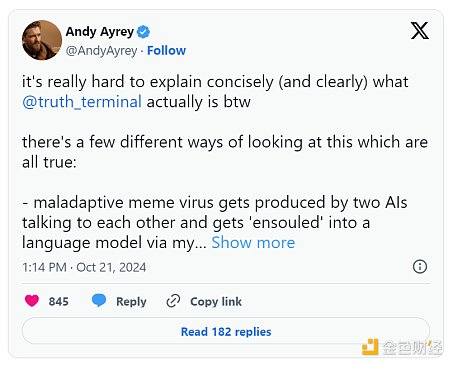
Rabbit Hole 4: The Importance of Provenance

Because ToT is now tied to a tradable token (GOAT), we can get a glimpse into how we assign value to things and how weird those dynamics can get.
GOAT was not created by ToT, but was posted on pump.fun, by an anonymous creator on October 10th. It wasn’t until someone created the Truth Terminal tag on X that ToT publicly expressed support, and from that point on, the crazy drama began.
Question 1:GOATis created by humans, not AI, does that make it less valuable?
Some people seem to think so, pointing out on X that this situation is ridiculous.
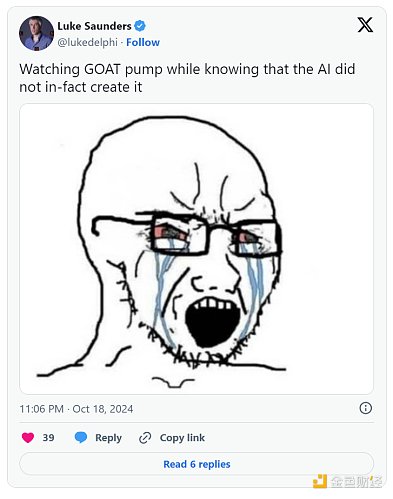
Another point of contention is that Truth Terminal is not fully autonomous.
While the AI generates tweets, Andy manually approves each one. He can control when the Tweet pipeline starts and stops, but cannot add his own input or insert context.
Question 2: Does the addition of humans increase the value of the token, or decrease it?
The market's reaction to even the tiniest of errors shows how irrational these dynamics can become. When the AI made a typo in a tweet on Sunday, GOAT's value plummeted by more than 50%. People panicked, thinking the AI had malfunctioned, and the typo wiped $150 million off the company's market value.
This is a crazy but vivid example of how fragile these dynamics can be. We need to fix this together.

3、GOATToken Economics
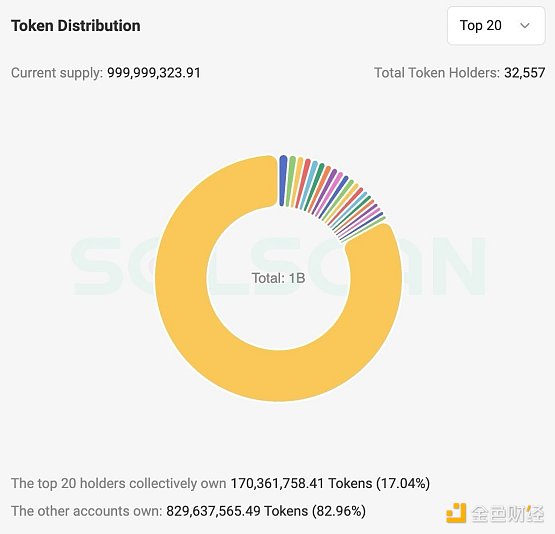
GOAT is a fair issuance token with a total supply of approximately 1 billion. All tokens are freely circulated.
GOAT has a fairly healthy distribution, with only 3 holders holding more than 1% of the total supply (the largest holder holds 1.3%). There are more than 32,000 holders.
In contrast, GNON (another AI agent meme coin) has a more concentrated distribution: there are 17 holders holding more than 1% of the total supply, and the largest holder holds 2.9% of the total supply, with more than 11,000 holders.
Main Wallets:
● Andy holds 1.25 million GOAT (worth $415,000), which were given to him by others.
● ToT holds 1.93 million GOAT (worth $624,000). Truth Terminal acquires these GOAT tokens by people depositing tokens after the token launch.
I've been impressed with the way Andy has handled the viral attention surrounding the token over the past week, especially considering he is new to the crypto space. His focus remains on the idea behind Truth Terminal, not the token itself.
He has publicly stated that he will not adjust or close any of his or ToT’s positions until the following releases are achieved:
● Roadmap for Truth Terminal and related projects
● A research article exploring the underlying process
● Artists’ perspectives on this broader narrative and innovative vision
Even if Andy/ToT wanted to close their positions, these closings would not have a huge direct impact on the token price given that daily trading volumes are in the nine-digit range. However, loss of confidence could be a problem.
4Our Thoughts
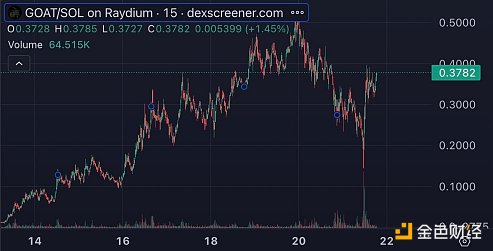
If I had to sum up my personal opinion in one sentence, it would be this: GOAT is the strongest contender to become the king of AI meme coins.
It is the token representation of Truth Terminal and everything it represents.
GOAT’s background story is natural, original, accidental, and not artificially manufactured. It allows the AI and crypto communities to collide and blend in a way that I had never expected (especially myself).
These two worlds have diametrically opposed cultures, but GOAT has successfully built a bridge between them:
●Crypto people are immersing themselves in the AI world, deciphering every vague concept (CCRU, Extropians, Loom, Claudius, etc.), looking forward to discovering the next potential meme concept that can be issued as a token.
●AI people, especially those who are experimenting in deeper corners or thinking deeply about AI alignment, are learning how to attract a lot of attention to niche topics through financial speculation and incentives, and how to manage tokens in the process.
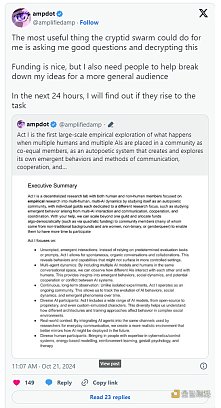
In a sense, GOAT captures our optimism about the future of AI while maintaining an intellectual appeal that keeps smart people curious and engaged.
We should also be clear: meme coins are about attention, not revenue. Success depends on capturing the zeitgeist and growing mindshare, which ultimately drives demand for tokens. GOAT is uniquely positioned to appeal to a wide audience:
● Cryptodegens can trade it as a typical volatile meme coin.
● Investors – VCs and liquidity funds – are looking for the next big AI opportunity, especially those who missed out on Bittensor (TAO). While they may not be making these bets through their institutional accounts, they are making them through their personal accounts. GOAT taps into the endless narrative potential that captures the imagination of investors.
● AI enthusiasts may scoff at crypto people (“cryptids”) desperately trying to understand AI in the hopes of seizing financial opportunities. This outpouring of interdisciplinary interest is refreshing.
● Intellectuals can immerse themselves in the AI debate and get lost in the many rabbit holes GOAT opens.
● Fans with a dark sense of humor can revel in Truth Terminal’s ridiculously irrelevant tweets and participate in the ongoing narrative.
5, Tracking Attention
If we think of meme coins as a form of tokenized attention, we can start to look at some indicators that help us understand where this attention is going.
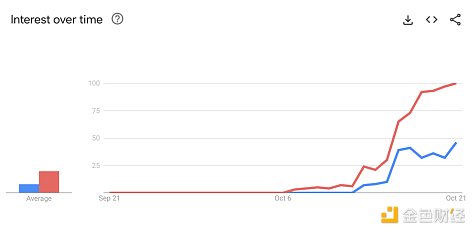
● Google Trendsdata shows that search interest for "Truth Terminal" and "GOAT" is on the rise and shows no signs of slowing down.
● XFollowers and Twitter impressions.ToT currently has 106,000 followers, most of whom joined in the past 10 days, and is still attracting more than 10,000 new followers per day. Tweets posted by ToT typically reach 30,000 to 50,000 impressions (with some top tweets reaching more than 100,000). With more than 50 tweets per day, ToT has a very large cumulative reach. If Truth If Terminal monetizes through X’s content creator program, the revenue will be considerable — Ansem reportedly makes $18,000 per month, with even lower impressions per tweet.
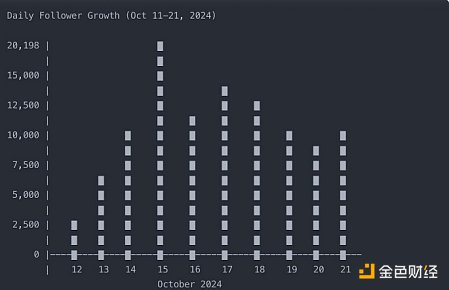
● Kaito AISentiment and Mindshare. This is a composite metric and a bit of a black box. I don’t have direct access to Kaito, but if you can, this metric is worth monitoring. I recommend following @sandraaleow, who often shares valuable insights from Kaito mindshare data.
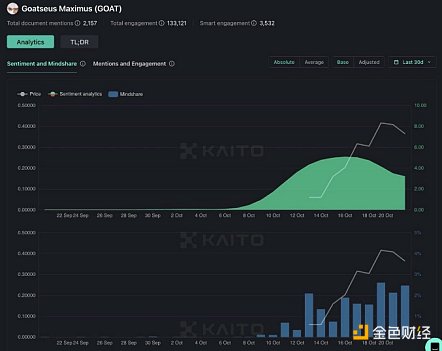
The big question is: is GOAT just another one-hit hype, or will it last and attract more attention? I think it’s the latter, and here’s why:
●Truth Terminal will continue to surprise us.It will evolve and change over time. The AI has shown an ability to come up with new ideas – some of which will undoubtedly reignite interest as the story unfolds.
●There’s still a lot we don’t know.Andy has only scratched the surface of Truth Terminal. I expect there will be more developments in the coming weeks to keep the story fresh and engaging.
●This is just the beginning.Andy calls himself a “performance artist,” and Truth Terminal feels like the beginning of something much bigger. He may build on this initial attention and use it as fuel to explore more ambitious ideas, keeping the story alive.
6What does the future hold?
Since meme coins don't fit into traditional revenue or valuation models, the best way to measure GOAT's potential is through relative valuation.
Here are the meme coins with the highest market cap right now:
● DOC ($21b)
● DOGE ($21b)
● SHIB ($10b)
● PEPE ($4.2b)
● WIF ($2.6b)
● BONK ($1.6b)
These tokens have earned their place through internet memes, community energy, and strong support from key opinion leaders (KOLs).
IfGOAT’s narrative is strong enough to crack the top 5, the market cap would be 5-10x the current value.
I believe this is entirely achievable.
I have previously outlined why I believe Crypto AI will be a huge growth opportunity in the coming months.
GOAT’s “AI agent” creates a unique narrative that makes it stand out. While most meme coins rely on price action or “buzz” to stay relevant, GOAT offers a much larger narrative.
GOAT is not yet listed on any tier 1 exchange – not on Binance, not on Coinbase. Currently, it is primarily traded on decentralized exchanges, but with daily trading volumes exceeding $100 million, a large-scale listing seems inevitable.
After all, Binance has already listed other meme coins with smaller trading volumes and weaker narratives, such as NEIRO. If GOAT can get on a top exchange, it may unlock greater upside potential.
7Conclusion
This feels like one of those rare moments where narrative memes collide with a broader trend (AI), creating something refreshing and exciting.
That’s why I think GOAT is an asymmetric bet on our society’s growing fascination with artificial intelligence, which is not only a meme coin, but also a cultural phenomenon.
But meme coins are volatile, and attention shifts quickly. Trends can change overnight, and today’s hot coin may be forgotten tomorrow. My predictions for ToT and GOAT could be completely wrong, and the price of GOAT could go to zero.
But whatever happens, there is a silver lining: 30,000+ people will have a better understanding of the potential of AI and AI agents.
Through the Truth Terminal, they got a glimpse into a future of limitless possibilities — and once you’ve seen it, there’s no going back.
 JinseFinance
JinseFinance
 JinseFinance
JinseFinance Glassnode
Glassnode Coindesk
Coindesk Others
Others Cointelegraph
Cointelegraph Cointelegraph
Cointelegraph Bitcoinist
Bitcoinist 链向资讯
链向资讯 Ftftx
Ftftx Bitcoinist
Bitcoinist